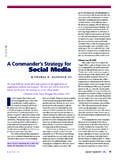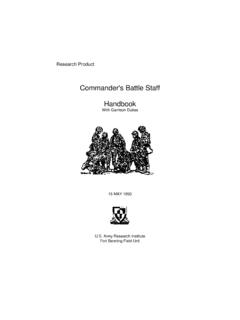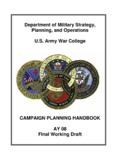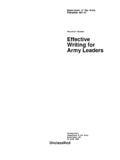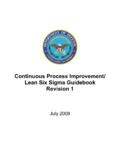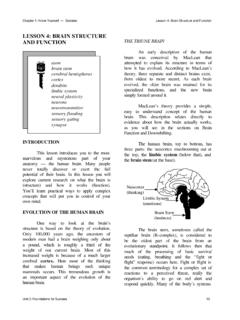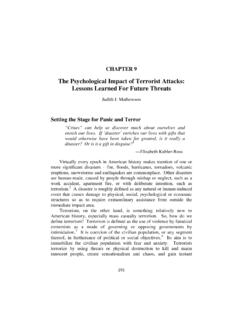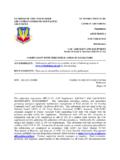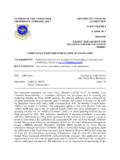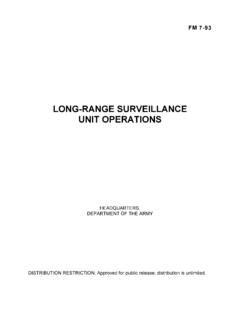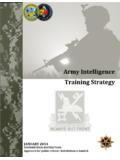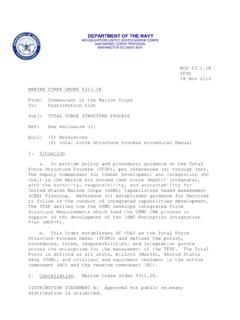Transcription of If the enemy commander has 10 possible courses …
1 66 March-April 2000lMILITARYREVIEW Intent = Purpose + Method + Endstate. Intent should have five elements. It should have two elements. It s Aftragstaktik made simple for the masses. It should be a structured process. It should be informal. THESE STATEMENTS about commander sintent, some of them obviously contradictory,were collected a few years ago from CombinedArms and Services Staff School (CAS3) students andArmy War College (AWC) students all combat armsofficers. Their understanding of commander s intentclearly demonstrates that although the concept ofintent has been in our doctrine for quite a while, con-fusion still exists. Yet, there has been little empiri-cal investigation into the process of communicatingintent.
2 After a brief review of what Army doctrineand other literature have to say about intent, this ar-ticle will present the sobering findings of one studythat investigated the communication of intent in fouractive-duty combat arms battalions. Next, the ar-ticle will propose a method to help commanders im-prove their ability to communicate intent to theirsubordinates. Finally, the article will argue that theprocess of communicating intent is subordinate toanother process known as imparting s Intentin Doctrine and PracticeAlthough US Army commanders have long usedintent to guide the actions of subordinates, it hasonly recently been formally included in s intent first appeared in US ArmyField Manual (FM) 100-5, Operations, in the 1970s, the military tended to centralizedecision making.
3 Events such as the failed hostagerescue mission in Iran signaled the need to empowersubordinate commanders on the scene. Army doc-trine writers used the German army s Aftragstaktik,first introduced in the early 19th century, as a modelfor today s concept of commander s , best translated as mission-orientedcommand, was developed in response to the Frenchrevolution and Napoleon s method of waging war,which swept away the traditional armies and theirlinear tactics, iron discipline, blind obedience andintolerance of independent action. 2 According Silva, Aftragstaktik was not a set of proceduresbut a philosophy, a social norm within the Germanarmy. At its foundation was the realization that battle is marked by confusion and ambiguity.
4 TheGerman army leaders consciously traded assuranceof control for assurance of self-induced action. These leaders developed a military cultural normthat supported and expected decisive action by sub-ordinates in the face of uncertainty or to the success of Aftragstaktik in theGerman doctrine was trust. Silva writes: Trust between superior and subordinate is thecornerstone of mission-oriented command. The su-perior trusts his subordinate to exercise his judgmentand creativity, to act as the situation dictates to reachthe maximum goal articulated in his mission; thesubordinate trusts that whatever action he takes ingood faith to contribute to the good of the wholewill be supported by his superior.
5 3If the enemy commander has10 possible courses of action, but thefriendly commander , restricted by the seniorcommander, has only one course of actionavailable, the enemy clearly has the , if the friendly force s senior commander ,through a minimally constraining intent state-ment, empowers his subordinates, they canadapt to any situation they 2000lMILITARYREVIEW67 MILITARYREVIEWlMarch-April 2000 Silva indicates that such confidence in subordi-nates stems from the superior s intimate personalknowledge of each one. German senior commandersknew that such knowledge was essential to imple-menting formalizing Aftragstaktik into US Army doc-trine, the fullness of the concept was diluted. The1993 version of FM 100-5 defines commander s in-tent, but there is no discussion of social norms,expectations, trust or intimate personal knowledgeof subordinates.
6 Instead, FM 100-5 focuses onstructure and content rather than process. The commander s intent describes the desiredendstate. It is a concise statement of the purposeof the operation and must be understood two levelsbelow the level of the issuing commander . It mustclearly state the purpose of the mission. It is thesingle unifying focus for all subordinate is not a summary of the concept of the purpose is to focus subordinates on what has tobe accomplished in order to achieve success, evenwhen the plan and concept no longer apply, and todiscipline their efforts toward that intent statement is usually written but can beverbal when time is short. It should be concise andclear; long narrative descriptions of how the com-mander sees the fight tend to inhibit the initiativeof the subordinates.
7 4 Intent in practice. Gary Klein s study of intentstatements and preliminary investigations indicatedthat intent statements often do not comply withdoctrine s content and structural guidance. Kleincollected 97 intent statements for analysis and foundthat their lengths ranged from 21 to 484 words, withmost of them averaging between 76 and 200 is an intent statement written by a brigade com-mander deployed to the National Training Center(NTC), Fort Irwin, California. The purpose of X Brigade s operation is to pro-tect the Corps, rear and build-up of follow-onfriendly forces. In support of Division and Corps,we must attack rapidly to the west in the CentralCorridor, destroy the lead motorized rifle battalion(MRB) of the XXX Motorized Rifle Regiment (MRR)between Phase Line (PL) IMPERIAL and PL EXCAL-IBUR, and then seize defensible terrain along PLEXCALIBUR.
8 To do this, X-X Infantry (Light) willinfiltrate to secure Hill 780 (NK4411), deny the enemyits use, and block to the west to prevent the enemy suse of the mobility corridor between Hill 780 andthe south wall of the Central Corridor (Avenue ofApproach 3). Task Force X-XX, the brigade maineffort, will move to contact in zone, fix the advanceguard main body (AGMB) and destroy it with anenveloping attack in depth. Brigade deep artilleryfires, close air support and scatterable mines willbe designed to attrit its commitment into the Brigadezone, and force the AGMB into the southern avenueof approach, where TF X-XX can destroy it by directfires. After destruction of the MRB in zone, TF X-XXwill continue the attack to seize defensible terrainalong PL EXCALIBUR.
9 End state visualized is leadMRB of XXX MRR destroyed; brigade with heavyforces in control of Brown and Debman passes; andbrigade postured to conduct defensive operations todestroy follow-on enemy regiments. 6 This brigade commander took pride in his clear,doctrinal intent statements. Unfortunately, in thiscase, he missed the mark. The italicized portion thatdominates this long intent statement is method. Ittells each subordinate unit what to do, and the de-tail limits the flexibility of subordinate command-ers for if they fail to accomplish the tasks listed, theyfail to achieve their commander s an operation order briefing held later duringthis same brigade s NTC rotation, a battalion com-mander asked for clarification of his unit s brigade commander , somewhat frustrated, said, OK, you want your brigade commander s priority?
10 Take care of this. If you don t get this right thenTF X-XX will not be able to get through. The bri-gade commander s response was, arguably, a muchclearer intent statement than the written form thathe had spent so much time versus synchronization. The differ-ence between the brigade commander s written andverbal intent statements highlights the tension be-tween the constructs of centralization and flexibil-ity. The senior commander must make an inherenttradeoff which impacts the subordinate com-mander s ability to adapt to battlefield battlefield is a highly complex, uncertain envi-ronment where a commander matches wits with hisopponent while coping with such variables as ter-rain, weather, morale, fatigue and subordinate commanders a large Silva, Aftragstaktik was not a setof procedures but a philosophy, a social normwithin the German army.
